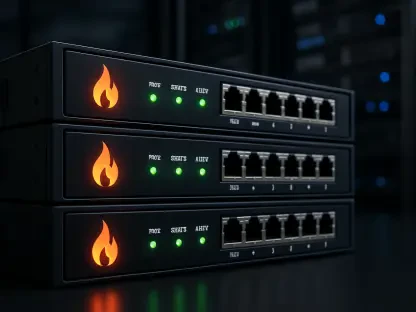In the ever-evolving landscape of industrial communication infrastructure, the Industrial Wireless Ethernet Bridge Market has emerged as a critical component driving operational efficiencies across various sectors. This market, projected to reach approximately USD 3.2 billion by 2032, is witnessing substantial growth spurred by the need for robust wireless connectivity solutions in remote and industrial settings. As modern industries progressively integrate smart manufacturing technologies, these Ethernet bridges become indispensable, providing the seamless transfer of data essential for Industry 4.0. The adoption of these devices significantly reduces cabling expenses and installation efforts, making them an attractive option for industries like oil & gas, utilities, transportation, and mining. The surge in industrial automation and increasing demands for secure, reliable, and long-distance data transmission bolster the prominence and anticipated expansion of the market from 2025 to 2032.
Market Segmentation and Dynamics
The Industrial Wireless Ethernet Bridge Market is strategically segmented to address the diverse needs and functionalities required by different industrial applications. This segmentation includes type, frequency band, and end-use industry, each playing an essential role in the market’s evolution. Under type segmentation, point-to-point and point-to-multipoint wireless bridges are fundamental options. Point-to-point bridges provide direct communication links between two distant sites, offering secure connectivity suited for isolated industrial applications. Conversely, point-to-multipoint bridges function as central hubs connecting various points within a network, thereby facilitating extensive data sharing throughout an industrial setup.
Frequency band segmentation primarily focuses on 2.4 GHz, 5 GHz, and other licensed microwave bands. The prominence of the 5 GHz band is notable due to its capability to deliver higher bandwidth while minimizing interference, thus supporting demanding industrial applications. As industries seek to minimize downtime and enhance data throughput, frequency bands with greater bandwidth and stability become increasingly relevant. The market is also segmented by end-use industries, which include oil & gas, transportation, manufacturing, mining, and energy & utilities. Manufacturing and energy sectors are especially significant consumers, driven by the implementation of IoT applications that necessitate versatile and reliable wireless communication solutions.
Technological Advancements and Industry Developments
Technological innovations are at the heart of the market’s vibrant expansion, with companies actively enhancing product offerings to meet industrial demands for efficiency, security, and scalability. Renowned players such as Cisco Systems, Siemens AG, HMS Networks AB, Moxa Inc., and Ubiquiti Inc. are at the forefront, developing advanced solutions designed to address specific industrial needs. Cisco, for example, has recently introduced ruggedized wireless access points compatible with industrial Ethernet bridges, facilitating advanced data communication capabilities. Meanwhile, Siemens has upgraded its Scalance W series, catering to heightened bandwidth requirements and bolstered cybersecurity protocols, aligning with the increasing emphasis on data protection.
New market entrants leverage cutting-edge developments such as 5G and Wi-Fi 6 technologies, devising Ethernet bridges that enhance network performance with low latency and larger coverage areas. Cambium Networks, for instance, has introduced next-generation point-to-point bridges that incorporate 256-QAM modulation and beamforming technologies, while Ubiquiti’s latest firmware updates integrate improved security protocols and interference mitigation. These advancements underscore an industry-wide commitment to innovation, as companies strive to offer solutions that not only enhance connectivity but also provide robustness, scalability, and ease of integration into existing systems.
Regional Analysis and Investment Opportunities
Geographical regions exhibit differing levels of adoption and market dynamics based on industrialization and digital strategy priorities. North America stands at the forefront due to its rapid technological advancements and solid industrial foundation. The region, with the United States playing a pivotal role, continues to prioritize digital infrastructure developments, presenting a fertile ground for the adoption of wireless Ethernet bridge solutions. Similarly, Europe witnesses significant progress, with countries like Germany, the United Kingdom, and France investing extensively in Industry 4.0 and smart grid initiatives that demand enhanced communication infrastructure.
The Asia-Pacific region emerges as a powerhouse of growth potential, driven by rapid industrialization in nations such as China, India, South Korea, and Japan. Initiatives centered on smart cities and manufacturing modernization provide a strong impetus for expanding the market presence and adoption of state-of-the-art wireless technologies. In contrast, Latin America and the Middle East & Africa see gradual yet consistent growth patterns. Brazil and Mexico improve industrial automation strategies, particularly in mining and energy sectors, while the UAE and Saudi Arabia spearhead infrastructure upgrades spurred by economic diversification efforts.
Future Outlook and Strategic Implications
The future trajectory of the Industrial Wireless Ethernet Bridge Market is intricately linked to the ongoing digitalization and automation of industrial operations. This trend underscores a critical need for high-speed, reliable wireless communication networks capable of supporting complex and data-intensive industrial tasks. Emerging technologies, including 5G connectivity, AI, and edge computing, are set to revolutionize the capabilities of wireless Ethernet bridges, ensuring robust industrial networks that are both resilient to disruptions and responsive to changing demands.
These advancements and trends will likely drive continued research and development efforts, paving the way for next-generation solutions characterized by extended range, advanced interference resistance, and fortified cybersecurity. With the global economy gradually stabilizing and industrial investments rebounding from recent disruptions, the demand for effective wireless communication solutions is set to increase, reinforcing the essential role of Ethernet bridges in future industrial communications. The successful adoption of these technologies will not only enhance operational efficiencies but also solidify their role as facilitators of the next wave of industrial innovations.
Summation of Key Takeaways
Reflecting on the evolution and current dynamics of the Industrial Wireless Ethernet Bridge Market, it is clear that this sector is set for considerable growth. This anticipated expansion is largely driven by technological advancements and a significant shift towards automated operations across industries. Established companies, along with newcomers, are actively shaping the market’s ever-changing landscape. They are providing innovative products that meet a diverse range of industrial requirements. The effective implementation of wireless Ethernet bridge technologies is crucial, not only for enhancing future operational efficiencies but also for facilitating industrial innovations that define the digital age. Such advancements underscore the critical importance of Ethernet bridges in both current and future industrial paradigms. As industries increasingly embrace digitalization, the need for efficient and reliable communication networks becomes paramount. Consequently, the evolution of the Industrial Wireless Ethernet Bridge Market is pivotal in supporting this transition, ensuring seamless connectivity and boosting technological growth across various sectors. By continuing to push the boundaries of what is possible, these technologies enable industries to remain competitive in a rapidly evolving digital landscape, achieving greater operational efficiency and innovation.









